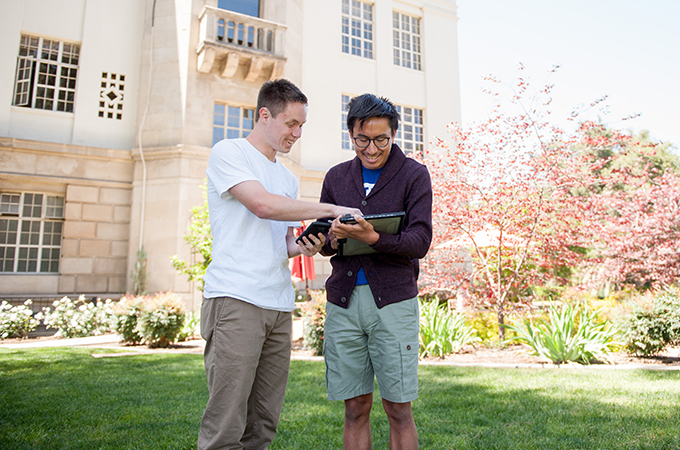As University of Redlands seniors, David Galindo ’18 and Sean Unger ’18 needed community service learning credits. As stewards of one of the most storied cities in Inland California, leaders of the Redlands Area Historical Society (RAHS) wanted a contemporary way to connect to audiences.
And as matchmaker, bringing the students together with the historical society, was Professor of Computer Science Trish Cornez. When Galindo and Unger asked Cornez, who taught mobile development for Androids, if she could find a way for them to do coding work for community service, she contacted RAHS, among other organizations, to see if Redlands students could contribute.
“[Community service learning] provides an invaluable awareness of an active community and the ways it can impact society,” said Cornez. “We’re always looking for different opportunities for our students, and it helped that Director of Community Serving Learning Tony Mueller was very flexible with how our students could fulfill those credits.
Ron Running, president of the historical society, was already working with Ben Parker, a member and retired Esri employee, on mapping features for the RAHS website. He welcomed the idea of Redlands students creating a mobile app, which would enable them to showcase the more than 350 homes that had received a Heritage Award from RAHS since 1975 for people on the go.
Galindo and Unger built the RAHS Explorer app—which can be searched by address, date of building, architectural style, builder, and architect—from scratch, with guidance from Running, Cornez, and Parker. Parker also encouraged the students to use Esri’s ArcGIS tools.
The students—who are best friends, former housemates, and cross-country team members who both graduated with honors in April—weren’t necessarily history buffs, but Galindo had always been very interested in making mobile applications and created them for fun. The RAHS project appealed to a different side of his curiosity: “I was always interested in the ‘why’ of things. [Working on the app] made me realize Redlands isn’t just a quiet town. There’s a lot that has happened here.”
The Redlands Area Historical Society paid the developer license fees of $100 for each of the students so they could begin coding, and they started the work in summer 2017. The Android version was finished in October; the iOS version was completed a few months later.
After receiving community service learning credits, RAHS turned Galindo and Unger’s continued work into an internship and gave them a scholarship award as a token of appreciation.
“The process was time-consuming and challenging,” Galindo said. “But that was my favorite part—being able to work with my best friend and learn together by building something from scratch. It was a test for me and Sean to come up with a real-world product that others can use and enjoy. And right now I feel confident enough to build pretty much anything.”
The app has helped the Redlands students boost their portfolios. “Creating the app motivated me to work towards a career in mobile development, which is what I'm shooting for,” Unger said. “This is the best thing that I have on my resume.”
Galindo, who grew up in East Los Angeles, is now working for a start-up app developer in El Segundo. Unger, originally from Carlsbad, was offered a mobile development job in Atlanta.
Cornez thinks their work is a testament to U of R’s close-knit community and the Computer Science Department as well. “Our students are acquiring really important tools, such as learning mobile development, so they can go out and get these opportunities. And right away [our students are] successful.”
Since the duo own the code, they are hoping to find different applications for the app to monetize it. “Once the data is created, all we have to do is implement the features into the same skeleton,” Unger explained. They could approach other cities with a rich history about making a similar app, for example. “But there are many different applications we can use it for—like in Los Angeles, it can be used to see which buildings have rent control. I’d definitely like to explore that by talking to other cities,” Galindo said.
In the meantime? “I love being in a random part of Redlands, opening up the app, and seeing what’s around me,” Galindo said.
Download the RAHS Explorer app for Google or Apple operating systems or learn more about University of Redlands’ Computer Science and Community Service Learning Programs.






